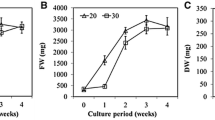Abstract
The focus of this study was to test the effects of 2,4-D, sucrose, culture media and initial inocula on the development of embryogenic suspension cultures of Ocotea catharinensis Mez. (Lauraceae). Suspension cultures were established in half-strength MS medium supplemented with 2% (w/v) sucrose either in the absence or in the presence of 2.2 µM 2,4-D, when higher cell viability was achieved. Under this culture condition the maximum fresh weight increase occurred in the fourth week. The cultures were yellow and consisted of a mixture of highly cytoplasmic single cells and small cell aggregates (<0.25 mm). The best proportion of inoculum per volume of medium for suspension culture development was 5% (w/w). Suspension cultures consisting of somatic embryos at the globular and cotyledonary stages (structures ranging from 1 to 3 mm) were successfully established on half-strength MS supplemented with 2% (w/w) sucrose through repetitive embryogenesis from the desiccated mature somatic embryos used as initial inoculum. The failure to initiate liquid cultures from non-desiccated mature somatic embryos was overcome by pre-treatment with air desiccation and reduction of the water content to 6.1 g H2O g−1 dry weight.
Similar content being viewed by others
References
Anderson WC (1978) Tissue culture propagation of Rhododendrons. In vitro14: 334
Benson EB (1994) Cryopreservation. In: Dixon RA & Gonzales RA (eds) Plant Cell Culture a Pratical Approach (pp. 147-168). IRL Press, Oxford
Carvalho PER (1994) Espécies Florestais Brasileiras. Recomendações Silviculturais, Potencialidades e Uso da Madeira. Embrapa-CNPF/SPI, Brasília
Figueiredo SFL, Simões C, Albarello N & Viana VRC (2000) Rollinia mucosa cell suspension cultures: establishment and growth conditions. Plant Cell Tiss. Org. Cult. 63: 85-92
Gamborg OL & Eveleigh DE (1968) Culture methods and detection of glucanases in suspension cultures of wheat and barley. Can. J. Biochem. 46: 417-421
Haragushi M, Motidome M, Yoshida M & Gottlieb OR (1983) The chemistry of Brazilian Lauraceae: neolignans from Ocotea catharinensis. Phytochemistry 22: 561-563
Kao KN & Michayluk MR (1975) Nutritional requirements for growth of Vicia hajastana cells and protoplasts at a very low population density in liquid media. Planta 126: 105-110
Kraemer KH, Schenkel EP & Verpoorte R (2002) Ilex paraguariensis cell suspension culture charaterization and response against ethanol. Plant Cell Tiss. Org. Cult. 68: 257-263
Leifert C, Pryce S, Lumsden PJ & Waites WM (1992) Effect of medium acidity on growth and rooting of different plant species growing in vitro. Plant Cell Tiss. Org. Cult. 30: 171-179
Lloyd G & McCown B (1981) Commercially feasible micropropagation of mountain laurel, Kalmia latifolia, by use of shoot tip culture. Intl. Plant Prop. Soc. Proc. 30: 421-427
Lordello ALL (1996) Chemical constituents from leaves, tissue and cell cultures of Ocotea catharinensis Mez. (Lauraceae). PhD Thesis, University of São Paulo, São Paulo, SP, Brazil (in Brazilian Portuguese with English summary)
McCown BH & Sellmer JC (1987) General media and vessels suitable for woody plant culture. In: Bonga JM & Durzan DJ (eds) Cell and Tissue Culture in Forestry Vol. 1 (pp. 4-16). Martinus Nijhoff Publishers, Dordrecht
Murashige T & Skoog F (1962) A revised medium for rapid growth and bioassays with tobacco tissue cultures. Physiol. Plant. 15: 473-497
Roy AT, Koutoulis A & De DN (2000) Cell suspension culture and plant regeneration in the latex-producing plant, Calotropis gigantean(Linn.) R. Br. Plant Cell Tiss. Org. Cult. 63: 15-22
Sakita MN & Yatagai M (1992) Essential oil of bark of Ocotea catharinensis Mez. (Lauraceae). Rev. Inst. Flor. 4: 684-687
Schenk RU & Hildebrandt AC (1972) Medium and techniques for induction and growth of monocotyledonous and dicotyledonous plant cell cultures. Can. J. Bot. 50: 199-204
Viana AM & Mantell SH (1999) Somatic embryogenesis of Ocotea catharinensis: an endangered tree of the Mata Atlantica (S. Brasil). In: Jain SM, Gupta PK & Newton RJ (eds) Somatic Embryogenesis in Woody Plants Vol. 5 (pp. 3-30). Kluwer Academic Publishers, Dordrecht
White PR (1963) The Cultivation of Animal and Plant Cells. 2nd edn. (pp. 57-63). Ronald Press, New York
Author information
Authors and Affiliations
Rights and permissions
About this article
Cite this article
Righetto Moser, J., Gonçalves Garcia, M. & Maria Viana, A. Establishment and Growth of Embryogenic Suspension Cultures of Ocotea catharinensis Mez. (Lauraceae). Plant Cell, Tissue and Organ Culture 78, 37–42 (2004). https://doi.org/10.1023/B:TICU.0000020387.96568.25
Issue Date:
DOI: https://doi.org/10.1023/B:TICU.0000020387.96568.25




